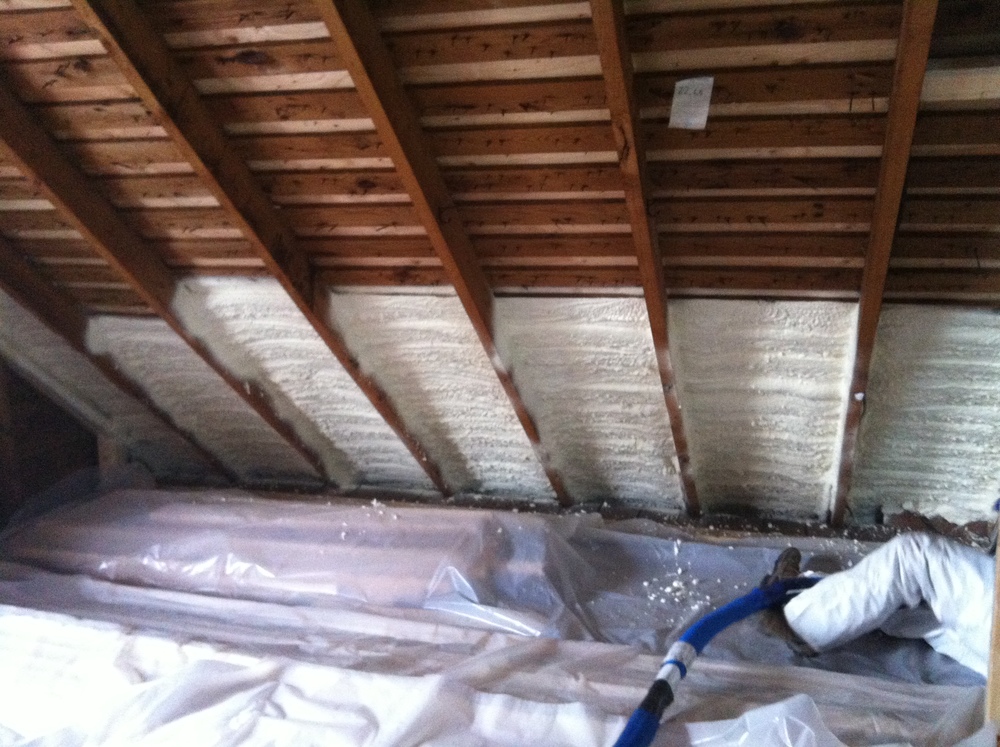Spray Foam: Frequently Asked Questions
Q: What is Spray Foam?
A: Spray foam is a material used as insulation and an air barrier. Spray foam insulation is installed with a spray foam gun, and combines two separate materials at the tip of the gun, which results in a chemical reaction that causes the material to expand so it can tightly fill building cavities. The Energia team uses spray foam to seal cavities in the ceiling and floor, walls, holes around electrical outlets and lighting fixtures, and gaps surrounding windows and doors.
There are two types of spray foam insulation: Open Cell Spray Foam (OCSF) and Closed Cell Spray Foam (CCSF), each of which has unique benefits. Open Cell Spray Foam is less expensive and offers many of the same benefits as closed cell, including high R-Value, durability, and air sealing properties. Closed Cell Spray Foam has an even higher R-Value and also has the added benefit of vapor protection.
Q: How Much Does Spray Foam Cost?
A: Energia uses two different kinds of spray foams, open cell and closed cell. For cost-effective Open Cell Spray Foam (OCSF), the general rule of thumb is to use $0.40 to $0.50 per board foot (a board foot is a square foot 1” thick). For example, a 3 inch thick application of open cell foam would cost up to $1.50 per square foot and have an insulation value of R13.
For higher performing Closed Cell Spray Foam (CCSF), the general rule of thumb is to use $1.00 to $1.15 per board foot. For example, a 3 inch thick application of closed cell foam would cost up to $3.45 per square foot and have an insulation value of R22.
The prices can vary based on scope of project; the cost per square foot may be lower for larger projects, or slightly more if the area is difficult to access or located further away. Generally, however, these are the ranges we use when determining the cost of your residential or commercial spray foam installation.
Q: What is Intumescent Paint and why is it sometimes required?
A: Intumescent Paint is a special barrier that helps meet the building code for fire protection when spray foam is going to be left exposed in certain areas. Except for spraying only a small strip around the top band of a basement or crawlspace wall, if the area is accessible for storage or servicing of mechanical equipment, then it must be covered. This fire safety barrier can also be achieved by using drywall or other approved coverings. This special paint can add another $1.40 to $1.50 per square foot to the area where it is required.
Q: What is the R-Value (Thermal Resistance) of Spray Foam?
A: R-Value measures the thermal resistance of a material; the higher the number, the more resistant the material and the more effective it is as an insulation. Each type of spray foam has a different R-value. The R-Value of Closed Cell Spray Foam (CCSF) varies slightly depending on the manufacturer and the thickness of the application, but generally is between R6.5 and R7.4 per inch.
Open Cell Spray Foam (OCSF) also varies slightly by manufacturer, but typically ranges from R3.9 to R4.2 per inch. As a comparison, fiberglass and cellulose usually have R-Values ranging between 3.3 and 3.7 per inch.
Q: What is the Difference Between Spray Foam and Other Insulation, in Terms of Blocking Air and Moisture? What is Vapor Permeability?
A: Both open and closed cell spray foams are effective air barriers, and can block air movement.
Moisture also travels in the air, in the form of vapor (also referred to as “water vapor”). This vapor is what creates humidity in the air. Vapor permeability is a the ability of water vapor to travel through a material. Closed cell spray foam is almost completely vapor impermeable, and will block the movement of all bulk moisture as well as water vapor.
Open cell spray foam, on the other hand, allows vapor to pass through the material. Its vapor permeability makes it unsuitable for certain areas where there is potentially higher humidity, moisture or vapor drive. Improper specification of the wrong foam in the wrong location can lead to compromise of the structure, and may result in dangerous rot and mold. Our experienced team will advise you which insulation is the best for which areas of your Western Massachusetts home or commercial building.
Q: How Long Does Spray Foam Take to Cure?
After installation, the foam expands very rapidly to fill all gaps and cracks. Typically, spray foam sets up within minutes and is fully cured 24 hours after installation.
Call us today to learn more about spray foam, and to schedule your installation.
WANT A FREE ESTIMATE?
Our team can provide free estimates for your spray foam insulation project.




